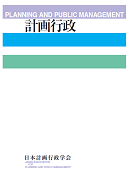Volume 28, Issue 3
Displaying 1-11 of 11 articles from this issue
- |<
- <
- 1
- >
- >|
Wisdom for Coexistence with Nature
Introductory Remark
-
2005Volume 28Issue 3 Pages 1-4
Published: September 15, 2005
Released on J-STAGE: April 05, 2024
Download PDF (3114K)
Special Articles
-
2005Volume 28Issue 3 Pages 5-15
Published: September 15, 2005
Released on J-STAGE: April 05, 2024
Download PDF (14094K) -
2005Volume 28Issue 3 Pages 16-26
Published: September 15, 2005
Released on J-STAGE: April 05, 2024
Download PDF (13856K) -
2005Volume 28Issue 3 Pages 27-34
Published: September 15, 2005
Released on J-STAGE: April 05, 2024
Download PDF (10498K)
Contributory Article
-
2005Volume 28Issue 3 Pages 35-44
Published: September 15, 2005
Released on J-STAGE: April 05, 2024
Download PDF (11542K)
Paradigm Shift in Universities
-
2005Volume 28Issue 3 Pages 45-46
Published: September 15, 2005
Released on J-STAGE: April 05, 2024
Download PDF (2346K)
Research Paper
-
2005Volume 28Issue 3 Pages 47-55
Published: September 15, 2005
Released on J-STAGE: April 05, 2024
Download PDF (11067K)
Research Note
-
2005Volume 28Issue 3 Pages 56-62
Published: September 15, 2005
Released on J-STAGE: April 05, 2024
Download PDF (9414K)
Local and Regional Planning
-
2005Volume 28Issue 3 Pages 63-69
Published: September 15, 2005
Released on J-STAGE: April 05, 2024
Download PDF (10429K)
Book Review
-
2005Volume 28Issue 3 Pages 70
Published: September 15, 2005
Released on J-STAGE: April 05, 2024
Download PDF (1271K) -
2005Volume 28Issue 3 Pages 71
Published: September 15, 2005
Released on J-STAGE: April 05, 2024
Download PDF (1292K)
- |<
- <
- 1
- >
- >|
